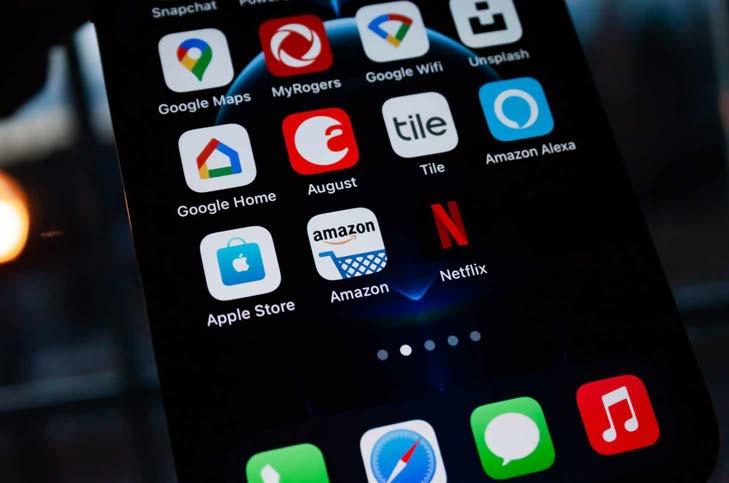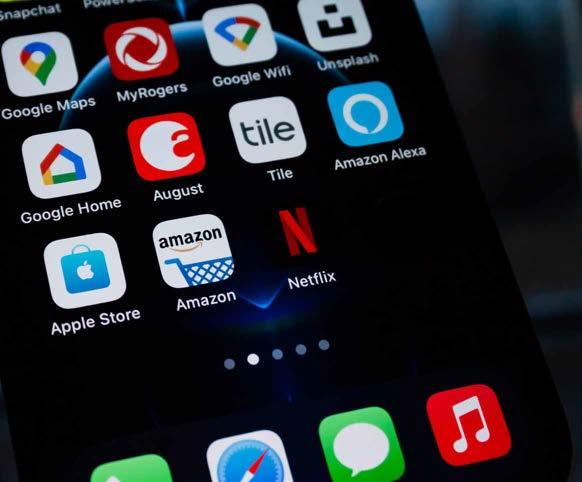
15 minute read
SUPPLY CHAIN
African marketers can benefit from boom in app uptake
A study in three key African markets shows that app installs have increased 41% in a year, emphasising their relevance to marketers.
AFRICA’S MOBILE APP MARKET is booming, fuelled by the Covid-19 pandemic, a rise of so-called ‘superapps, and the growing need for apps as online banking increases in popularity. This is according to a recent study released by Google in conjunction with AppsFlyer, an international mobile marketing analytics firm.
This is important news for the continent’s marketers, who are increasingly incorporating apps into their strategy. Doing so can help drive e-commerce, enhance brand loyalty and customer convenience, and promote in-store and other offline activity – through, for example, exclusive special offers to regular clients.
The study analysed more than 6 000 apps and two-billion app installs across South Africa, Nigeria and Kenya, and found that overall installs increased by 41%. The research took place over a year: between Q1 2020 and Q1 2021.
Nigeria showed the highest growth, with a 43% overall increase in installs. This was followed by South Africa with 37% and Kenya with 29%.
IN-APP PURCHASING REVENUE INCREASED
Perhaps driven by the pandemic and its associated lockdowns, inapp purchasing revenue increased significantly between July and September 2020, with an average 136% increase compared to the previous three months. This emphasised how much African consumers were spending within apps, from retail purchases to buying gaming upgrades.
In South Africa, in-app purchasing revenue surged by 213%. Nigeria showed a rise of 141% and Kenya’s in-app purchasing revenue was up by 74% over the same period.
As lockdowns took hold during the second quarter of 2020, installs of mobile apps increased by an overall 20% compared to the first quarter of the year. Most of this activity was in SA, where stay-at-home restrictions were the toughest. But Kenya also showed a significant uptick and there was a smaller rise in Nigeria. Other key findings from the study included: • South Africa and Nigeria saw year-onyear growth in finance app installs by 116% and 60% respectively, as the need to reduce social contact has led to even more users adopting digital solutions for their financial needs. • Android’s larger market share within sub-Saharan Africa has seen advertisers spend more budget on the platform. Non-organic installs increased by 54%, compared to 19% for iOS. The cost per install on iOS also increased by 21% between Q2 and Q3 2020, which meant iOS app

JAMES YAREMA, UNSPLASH PHOTO:
developers were getting fewer installs for the same budget. Towards the end of the year and into 2021, there was no uplift in non-organic installs on iOS compared to 40% on Android. • The report found similar levels of overall growth across verticals during the year, with gaming installs increasing by 44% and non-gaming increasing by 40%.
APPS ARE INCREASINGLY DRIVING BUSINESS REVENUE
“The mobile app space in Africa is thriving, despite the turmoil of the last year. Installs are growing and consumers are spending more money than ever before, highlighting just how important mobile can be for businesses when it comes to driving revenue,” said Daniel Junowicz, regional VP for Europe, Middle East and Africa at AppsFlyer.
“As a result, mobile marketing is becoming increasingly important for businesses across the continent. Being able to make data-driven informed decisions, and understand the ROI on marketing campaigns will be key to any app marketer’s success.”
Rama Afullo, Apps Lead for Africa at Google, added: “While it’s clear that mobile adoption is increasing, there’s still room for growth when it comes to app marketing, with many marketers in the nascent stage of their app maturity journey.”
African consumers’ uptake of mobile-based apps is in line with the growing penetration of smartphones on the continent and reflects global trends in apps.
CONSUMERS ARE USING MULTIPLE APPS
According to ABAMobile, a Spanishbased app developer that operates in various countries, the ease of download of mobile apps, and the presence they have in our lives, means that sometimes consumers are not aware of how many they use. A study in Europe found people use an average of 31 apps, but believe they only use 11.
“More and more companies are developing their own app because they realise that it’s a great opportunity. [Organisations] have to adapt to the social and technological changes, and one of the best solutions for this is by developing a mobile app that allows your business to grow,” ABAMobile says.
“In addition, if you think that mobile apps are only for big companies, you are wrong because these tools are being created by more and more small and medium-sized firms.”
ABAMobile lists five reasons for marketers to include apps in their strategy: • It makes the business available 24/7. • They enhance customer loyalty. • They can provide practical value to customers. • Apps can be a brand-builder. • Marketers can provide exclusive content and features not available to offline customers.
In the Covid-19 era there is also another key consumer benefit to always consider: perceived safety. By using an app to shop or otherwise transact with a business, people reduce their risk of exposure to the virus.
How smart numbercrunching can give campaign-winning insights
Data-driven marketing is an industry buzz-phrase. Yet relatively few businesses use it. Mike Simpson examines how it can give a critical edge.
TODAY AROUND 4.7-BILLION people use the Internet and 4.2-billion are on social media. An incredible 2.5 quintillion bytes of data is being created every day in 2021 (a quintillion is a million times a trillion, or a 1 with 18 zeros behind it) and that volume of data is expected to double every two years.
It equates to a lot of potential marketing data and customer insights for marketers. Providing, of course, data science can sort the wheat from the chaff and an analytics expert can determine what’s useful for particular marketing strategies.
Big data vs useful data. There’s a difference and top-quality data science can make big data very ‘useful’ indeed for marketing purposes.
Enter data-driven marketing as the way of the future. When marketing joins with data science to leverage big data effectively, marketers will likely achieve great campaign results.
But do all businesses use it and what are the consequences if they don’t embrace data science as a way to drive successful strategies?

LACK OF DATA SCIENTISTS IS HAMPERING UPTAKE
Possibly because of a lack of data scientists, plus the daunting nature and cost of analysing and effectively using massive volumes of marketing data, there is still a perhaps surprising lack of uptake.
According to Forbes business magazine, nearly 36% of companies don’t use all the big data they possess and 47% are only planning to implement a data analysis tool in the future. The same article quotes the ‘Meaningful Brands 2019’ report by the Havas Group, which projects that 81% of European brands could go extinct because they don’t create relevant content and can’t offer personalised discounts. So, a successful modern business needs to be everywhere and communicating in many different ways to maximise its potential opportunities.
As a marketing team, you can use data to be constantly aware of which channels are ‘hot’, which ones are not – and which marketing channels you simply can’t do without under any circumstances, even if they may seem ‘old’ and ‘bland’ to some.
Relatively few brands use big data insights
Only 19% of companies conduct customer behaviour analysis, segment their audiences correctly and personalise their campaign offers, Havas found. Taking note of this, Forbes points out that using data science to produce such insights would enable those organisations to “know what customers want and when they want it” and that the cost of marketing teams ignoring this information might be a “fast exit” from business.
So the effective uptake of data-driven marketing to drive campaigns still seems somewhat patchy. Therefore, it is safe to assume that organisations which can implement a successful data-focused marketing strategy should have a notable competitive advantage.
As marketers go about developing their data-focused campaign strategy, the following are some key data-driven trends to be aware of.
PERSONALISED MARKETING
Arguably, personalisation is the most crucial of the trends to successful campaigns. As even the most basic online course in marketing will teach you, a one-to-one relationship with the potential customer is the Holy Grail for all marketers.
The only reason that one-size-fits-all ‘spray-and-pray’ marketing activities existed in the past is because there wasn’t a viable way to narrowcast the message to a target audience of one, except in highly specific circumstances.
B2B marketers have generally been able to do this more easily, simply because of their highly defined audience.
But now modern technology and big data are, indeed, making hyperpersonalised messaging viable – whether it be via targeted website interactions, email campaigns, social media touchpoints, serving great content to highly specific audiences, or through other targeted mechanisms.
CROSS-CHANNEL MARKETING
Cross-channel marketing is another that’s vital, simply because the number of channels – and therefore touchpoints – where consumers expect to be engaged during campaigns continues to proliferate.
TikTok, for example, was a largely unknown social media platform only a few years ago, but has now become extremely important in many social media-based campaigns.
A DIVERSIFIED CONTENT STRATEGY
“You should also be diversifying your content strategy with a wide array of types in order to reach the highest potential audience on more channels,” advises Social Media Week. “This will also help your project build authority, which is critical in retention, churn reduction and overall brand loyalty.
“Yes, have a blog. It is a great SEO tool and you should already know how to be targeting keywords by now. But in addition to this, make videos, create infographics, launch a podcast, guest on other podcasts and YouTube channels, embrace networks like TikTok and Instagram, and contribute to other blogs. You should be producing diverse content constantly to be able to market to different channels.”
PHOTOS: ISTOCK PHOTO

EXAMPLE OF A SUCCESSFUL DATA-DRIVEN CAMPAIGN
An example of how marketing data can inform marketing campaigns is The Lion King movie. Meltwater, a software as a service (SaaS) solution business and the world’s first online media monitoring company, provided a solution to movie execs and their marketers looking to ensure that the 2019 remake of the 1994 classic would not follow the downward spiral of public ambivalence and apathy that bedevils so many remakes.
The insights gained by Meltwater from social media enabled the film’s marketers to fine-tune their strategy.
For example, by analysing over 5,000 mentions on news platforms around the world and more than 2-million social mentions just in November 2018, the importance of promoting the return of James Earl Jones to the remake (he also starred as a key character in the original) was clearly understood.
Fans were ecstatic when they heard the booming ubiquitous baritone voice of Jones (who played the character Mufasa) narrate the trailer for the remake and they soaked in the nostalgia of the reanimated classic.
In comparison, global megastar Beyonce’s involvement in the project had only a relatively small number of social mentions in the same timeframe. This interesting insight revealed that even the presence of an undoubtedly talented superstar such as Beyonce could not match the level of nostalgia that needed to be emphasised and harnessed when promoting the new version of the movie.
OTHER EFFECTIVE USES OF DATA IN MARKETING
Other examples of effective use of marketing data analysis include:
• YouTube, Netflix and other videostreaming platforms use constant analysis of past customer preference data to suggest other videos, movies and music that are likely to appeal to that customer. • The Weather Channel in the US analyses the geographic location of the millions of visitors to its website to sell highly targeted advertising opportunities to advertisers. For example, anti-fizz hair products to site visitors from humid climates, or skin moisturisers to people living in arid parts of the country.
• Automakers analyse the data that high-tech modern cars send back constantly via the cloud, to tailor personalised new product offers to those customers. For example: accessories, specialist driver training, or even new vehicle models that are better suited to their lifestyle.
PHOTOS: EVA RINALDI VIA WIKIPEDIA, RAWPIXEL › By analysing more than 2-million news and social media mentions in a single month, the importance of promoting the return of James Earl Jones to the remake of the Lion King movie became obvious

DATA-DRIVEN MARKETING, IN SUMMARY
To quote Vlad Flaks, Forbes columnist and CEO of OWOX BI, an all-in- one marketing analytics platform, effective use of data analysis gives you a competitive edge when you plan campaigns.
“Experience and even tested hypotheses aren’t a sufficient basis for decision-making,” he says.
“Your opinion or what you’ve done for years can completely differ from what your customers want today and are ready to pay for. Personalisation and smart interaction design are the two main features of market leaders. Your task is to know everything about your customers and forecast their next wishes and purchases.”
As marketing software company DemandJump observes: “As tools that leverage AI to combine and analyse various sources of data become more widely adopted, you can expect datadriven marketing to become the norm across all industries. There’s no better time than today to start using data-driven marketing principles for your business.”
Mike Simpson is the Editor of Strategic Marketing for Africa. He has 30-plus years’ experience in journalism, TV, media, marketing and PR. He founded his content-creation business, Simpson Media, in 2008.
The importance of CX and how to measure its ROI
While marketers know the value of an outstanding customer experience, the challenge is sometimes proving its bottom-line value to senior management. Nathalie Schooling outlines how to measure its ROI.

TODAY’S CUSTOMERS ARE more likely than in previous decades to switch brands if their expectations are not being met, not least because they have so many more easily accessible options available to them than in the past.
This makes the job of marketers extremely tough. Not only are they responsible for the correct positioning of a brand and its bottom-line growth; now they are also accountable for the end-to-end customer experience. This at a time when consumers are prone to ditch a brand at the proverbial drop of a hat – and tarnish its reputation on social media for good measure!
Research tells us that companies which focus on their customers are up to 60% more profitable. The challenge for marketers, however, is proving how much of that growth is directly linked to executing effective customer experience (CX) strategies. This lack of proof can jeopardise future investment in CX and, ultimately, overall long-term business growth.
A CX focus increases the company’s profit
Traditionally, companies that measure CX efforts have done so with two of the better-known metrics, NPS (net promoter score) and CSAT (customer satisfaction). While these metrics have their place, there is clearly a gap in their ability to truly position CX as an organisational priority. The main issue with NPS and similar customer satisfaction metrics is that the feedback is usually based on an isolated experience.
While this too can be the case with another popular CX metric – the CES (customer effort score) – this metric has proven slightly more effective in measuring customer experience. It works by identifying how much effort it takes to do business with a company, usually on a scale of 1-10, and can help organisations gauge their probability of customer retention.
This is important, because a Gartner study found that if a customer has an easy or low-effort experience with a brand, they are 94% more likely to repurchase.
The appeal of CES is that it enables a business to measure a specific customer service touchpoint, e.g., return of goods. Once an issue has been identified with a touchpoint, the CX manager can then measure future CES scores against previous scores and track progress.
A recent international report using input from 122 customer experience experts and published on the CX Network website revealed that, while NPS and CSAT were the most used CX metrics, 57% of the experts said there were many CX benefits that go unmeasured in their company. The reason for this could have a lot to do with the limitations of the metrics being used.
PHOTOS: LUKAS BLAZEK, NATHAN DUMLAO UNSPLASH.COM
For example, the reliability of NPS has recently been called into question as it has been found to produce misleading results by overstating the number of customers who are unhappy with a business.
For example, a survey conducted by independent research company ForeSee of 20 000 people categorised as ‘detractors’ by the NPS (who are
The real ROI of customer experience comes down to how well a marketer can analyse and use the data at their disposal
taken to be genuinely unhappy with the brand) found that just 1% of that total said they would communicate their ‘bad’ experience to others. So how bad could the experience have really been?
Further questioning revealed that 60% of so-called ‘detractors’ were loyal customers who had been using the brand for more than two years and intended to continue doing so.
THE IMPORTANCE OF DATA-DRIVEN CX
Achieving fast results and progress in the customer experience journey is more likely if one can pinpoint key focus areas to work on.
Often, ambitious marketers try and tackle too many problems at once. Instead, they need to take on projects that they know will give them reliable results. This will help drive trust and ‘buy-in’ from the higher-ups in the organisation.
The best way to obtain reliable results is to build the CX strategy with the end goal of proving ROI. For example, if an e-commerce company wants to increase the speed and reliability of its deliveries to make for a better customer experience, the marketer or customer experience manager can assess the impact of this by measuring repeat purchases, new customer purchases, and cross-sales since the faster delivery was put in place.







